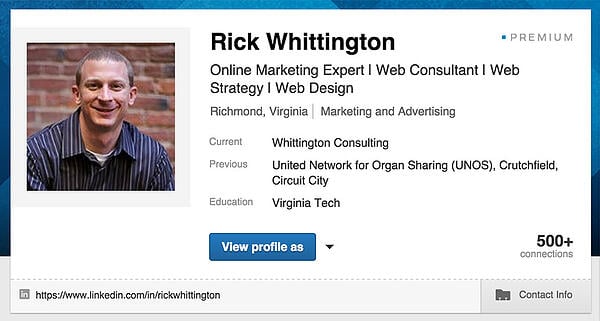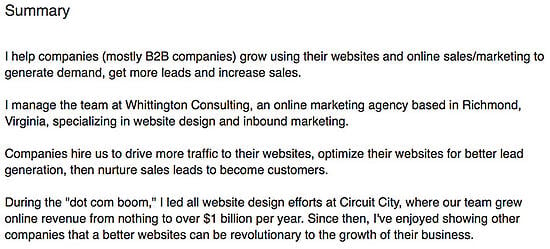B2B business professionals around the world agree that LinkedIn is a great way to network with prospective business partners. But many executives and sales professionals find themselves ready to network and interested in meeting new people (or even getting tons of views each week)… but not very confident that their LinkedIn profiles put their best foot forward.
When you put yourself out there, you need to make sure that the most interesting, compelling, and authoritative details are the first thing your contacts notice about your profile. We’ve covered a few of those basics before, but here’s a comprehensive list of our go-to tips for writing an incredibly compelling LinkedIn profile:
LinkedIn Profile Basics
Craft a strategic headline.
Listing your position is rarely informative enough. Include details about what it is you actually do for your customers or in your position at your job, such as “VP of Business Intelligence - Identifying Growth Opportunities in the Healthcare Industry.” Or you can take a look at Rick’s profile here, which includes the keywords “Online Marketing Expert | Web Consultant | Web Strategy | Web Design.”
Use organized formatting.
You can't use rich text in your LinkedIn profile like you can in Microsoft Word, which means you cannot bold, underline, or italicize anything. However, you can create organization with spacing and capital letters. Create a digestible summary by using appropriate paragraph lengths (about three lines per paragraph), and no more than two or three all-caps “introductory headers.”
Activate your profile’s unique link.
If you’ve just signed into LinkedIn as is, your profile link likely includes some numbers and random letters. Update your standard URL to create a clean, unique link that includes your full name. If your full name is already taken, create a link that includes your industry, location, or business.
Writing a LinkedIn Profile
Use keywords.
Your LinkedIn profile is searchable using the LinkedIn search bar. That means there is value in including important keywords that your customers and key contacts will use to conduct their business. Make a list of 2-3 of these keywords that you will emphasize within your profile and use each of them 2-3 times. Using more than this amount will make your profile less readable and less relatable to those who take the time to read it. You can also follow Rick’s lead and use these keywords in a list at the bottom of your profile to combine the best of both worlds:
Focus on the value you provide.
When it comes time to actually write your profile, don’t try to rewrite your resume. Instead, write value-focused statements much like you might provide in the mission statement of a resume or cover letter. What is it that you do for your customers and coworkers? What are your particularly valuable skills, be they specific to your industry (website design, acquisitions) or specific to your position (communication, identifying opportunities)?
As you can see in Rick’s example, he leads with the core purpose of his business, which is to help his customer grow their businesses using their websites. Then he expands on what he does on a day-to-day basis and finishes with a notable example from his work history that provides a case study for the value he provides. When writing your profile, aim for a short statement that identifies the value you bring to the table and an understanding of how you arrived where you are now.
Stick to a word count.
There’s no official average for LinkedIn profiles, but in general we find it best to stick between 100 and 300 words. Less, and you aren’t providing any distinguishing detail for those who read your profile. More, and you risk providing too much information for your contact to remember. Rick’s example above clocks in at a brisk 137 words but provides enough detail and information to kick off an interesting conversation.
Stay conversational.
Because working with LinkedIn might be a new experience, it’s easy to feel overwhelmed. When in doubt, treat LinkedIn like a traditional networking tool, like a business card or live networking event. Don’t use words or details on LinkedIn that you wouldn’t share at a live networking event. Write a summary or introduction that you would be comfortable reading over the phone to a new contact. If this proves to be very difficult, try recording yourself when you introduce yourself at your next conference call or meeting and transcribing what you said. You might be surprised to realize how quickly and succinctly you can describe your skills, value, and experience when you aren’t focused on typing it out.
Keep networking.
As you continue to be active on LinkedIn, you’ll find that more and more contacts click over to view your profile. However, you can also encourage more traffic to your LinkedIn profile by being more active on the platform. Once your profile is up to date and fit to be seen, take your networking a step further by investigating LinkedIn groups and building an active group of customers and referral partners within your industry.
Is your LinkedIn profile optimized to actively convey your skills and expertise?









